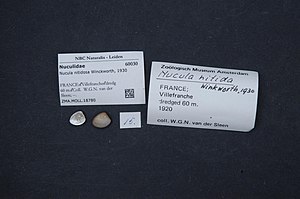Shiny nut shell
| Shiny nut shell | ||||||||||||
|---|---|---|---|---|---|---|---|---|---|---|---|---|

Shiny nut shell ( Nucula nitidosa ) |
||||||||||||
| Systematics | ||||||||||||
|
||||||||||||
| Scientific name | ||||||||||||
| Nucula nitidosa | ||||||||||||
| ( Winckworth , 1930) |
The shiny nut clam ( Nucula nitidosa , Syn .: Nucula turgida ) is a type of clam from the nut clam family (Nuculidae).
features
The flat, moderately expanded case is roughly triangular, but a little longer than it is high; the height reaches about 80% of the housing length. The cases are up to about 1.3 cm long. The vertebra is comparatively small, directed anteriorly, and sits behind the center, about 25 to 30% of the dorsal length from the posterior end; H. the case is longer at the front than at the back. The front part of the dorsal margin is slightly convex, the front end is well rounded. The posterior dorsal margin, on the other hand, is almost straight to slightly concave; it drops steeply to the angled end of the rear edge. The ventral margin is moderately deeply arched. The comparatively long lunula is lanceolate, but only indistinctly set off. The heart-shaped area also has only indistinct edges. The internally lying ligament is pear-shaped also sits on a well-formed resilifer . A barely visible, external ligament lies in front of the vertebrae. The lock is designed as an angled lock plate (up to 90 °). In the front part of the lock plate there are 20 to 30 long teeth, in the rear part 11 to 14 teeth. The teeth protrude from the tip of the Resilifer. The surface line is entire, not indented. The two sphincters, which are roughly the same size, are egg-shaped, but the muscle impressions are not particularly clear.
The ornamentation consists of very fine, closely spaced, radial lines that intersect with fine concentric growth strips and occasionally somewhat coarser concentric lines. This grid-like structure can stand out more clearly towards the edge. The peel is thin, but still quite firm. The periostracum is thin and smooth, the surface is shiny. It is gray-green to olive-green, often with purple-gray lines or bands, rarely the lines or bands are also orange-red. The shell itself is whitish to bluish gray, inside pearly.
Similar species
Compared to the large nut clam ( Nucula nucleus ), the shiny nut clam ( Nucula nitidosa ) is slightly higher in relation to its width. The angle of the front and rear of the lock barely reaches 90 °, while in the case of the large nut clam ( Nucula nucleus ) the angle is up to 100 °.
Geographical distribution and habitat
The glossy nut shell occurs in the eastern Atlantic from the Arctic to the coast of Angola . It also penetrates the North Sea and the Mediterranean .
It lives on muddy, fine sandy and sandy soils from about six meters water depth to 100 meters water depth.
Taxonomy
The taxon was established in 1833 by George Brettingham Sowerby II as Nucula nitida . The name is a younger, secondary homonym of Arca nitida Brocchi, 1814, the species was then placed in the genus Nucula , and was replaced in 1930 by Ronald Winckworth with the new name Nucula nitidosa .
In 1875, JT Marshall proposed the new variety Nucula nitida var. Turgida in a joint work by John Leckenby and JT Marshall . This name is also a more recent homonym, in this case from Nucula turgida Gould, 1846. This has often been overlooked in the past and the species has also been referred to as Nucula turgida in the literature . The species is now assigned to the genus Nucula Lamarck, 1799.
supporting documents
literature
- Fritz Nordsieck: The European sea shells (Bivalvia). From the Arctic Ocean to Cape Verde, the Mediterranean Sea and the Black Sea. 256 p., Gustav Fischer Verlag, Stuttgart 1969 (p. 4/5 as Nucula turgida )
- Rainer Willmann: Mussels and snails of the North and Baltic Seas. 310 p., Neumann-Neudamm, Melsungen 1989, ISBN 3-7888-0555-2 (p. 82 as Nucula turgida )
- Guido Poppe and Yoshihiro Goto: European Seashells Volume 2 (Scaphopoda, Bivalvia, Cephalopoda) . 221 pp., Verlag Christa Hemmen, Wiesbaden 1993 (2000 unc. Reprint), ISBN 3925919104 (p. 37)
On-line
Individual evidence
- ↑ George Brettingham Sowerby II: The conchological illustrations. London, self-published 1833 [http://www.biodiversitylibrary.org/item/43621#page/63/mode/1up Online at www.biodiversitylibrary.org (p. 5) or Fig. 20
- ^ Ronald Winckworth: Notes on Nomenclature. Proceedings of the Malacological Society of London, 19: 14-16, 1930
- ↑ John Leckenby, JT Marshall: North Sea Dredging. Annals and Magazine of Natural History, Series 4, 16: 390-394, London 1875 Online at www.biodiversitylibrary.org
- ^ World Register of Marine Species: Nucula nitidosa Winckworth, 1930